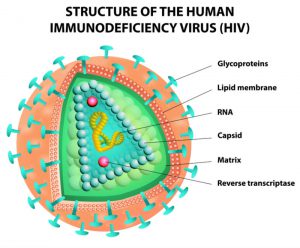In a recent study published in Science Advances, scientists from the Scripps Research Institute overcame technical hurdles to develop a new HIV vaccine candidate that stimulates the body to produce a powerful anti-HIV antibody response in animal experiments. The researchers say the new vaccine strategy is based on the HIV envelope protein Env, which has been found unlikely to be used to develop vaccines that stimulate specific immunity. In this study, the researchers found a simple way to keep the structure of the Env protein, even which of different HIV strains, in an ideal shape. When virus-like particles are used to mimic the entire HIV, stable Env can induce a strong anti-HIV antibody response in mice and rabbits. Candidate vaccines based on this strategy are being tested in monkeys. Prof. Jiang Zhu, one of the researchers, predicted that the new strategy could potentially solve the problems scientists have long faced in developing HIV vaccines.

HIV Env Protein
The Env protein on the surface of HIV can help the virus firmly seize the host cell and start the infection. Since the Env protein plays a critical role in infection and gives maximum exposure to infect host body’s immune system, it often serves as the main target for the researchers to develop HIV vaccine. The idea is to inoculate the whole Env protein, or its subunit, into the human body to stimulate the production of antibodies that bind to Env; the use of these antibodies may as well inhibit HIV’s later re-infection of the host.
Thus far, no effective HIV vaccine has been developed in large clinical trials. Many researchers believe that if the Env protein can be presented to the host immune system before HIV infects host cells, the developed HIV may be able to work effectively. However, in presenting Env proteins accurately, scientists often face huge challenges. In HIV, Env features the synaptic viral outer membrane characterized by tight trimeric structures. The shape of these complex structures is fundamentally adjusted both before and after cell infection. Despite extensive research, scientists still fail to find a widely applicable method to keep the Env trimer in an ideal pre-infection shape.
Research Report Introduction
Zhu said that to date researchers have reported some methods to stabilize HIV trimers, but they cannot be popularized. The metastability of Env trimers is considered an essential problem in the development of HIV vaccines. In the study, researchers claimed that their new approach, dubbed as the uncleaved prefusion-optimized approach (UFO), did work for Env trimers in diverse HIV strains. The approach can keep the Env in a closed shape. At present, researchers can modify the Envs of 30 to 40 varieties of HIV strains. By attaching stable Env trimers (up to 60 at a time) to a single nanoparticle, researchers were able to optimize HIV vaccine strategies so that a single nanoparticle could mimic the entire sphere structure of HIV. Although the vaccine molecules developed in this way are synthetic, they behave, immunologically, very like a truly invasive virus, thereby stimulating a stronger response.
After studying mice, the researchers found that in just eight weeks, the Env nanoparticle vaccine released antibodies that neutralized the naturally circulating HIV. Zhu said that in this study, the ideal type of antibody response in mice was induced for the first time using the candidate vaccine, and a similar result was observed also in rabbits, suggesting that this nanoparticle-based approach is significantly superior to the vaccine strategy developed through Env protein isolation.
Later studies will be conducted in 24 monkeys. Researchers are testing two vaccine candidates based on Env trimers from diverse HIV strains, and a vaccine candidate made from a mixture of three Env based vaccines.
